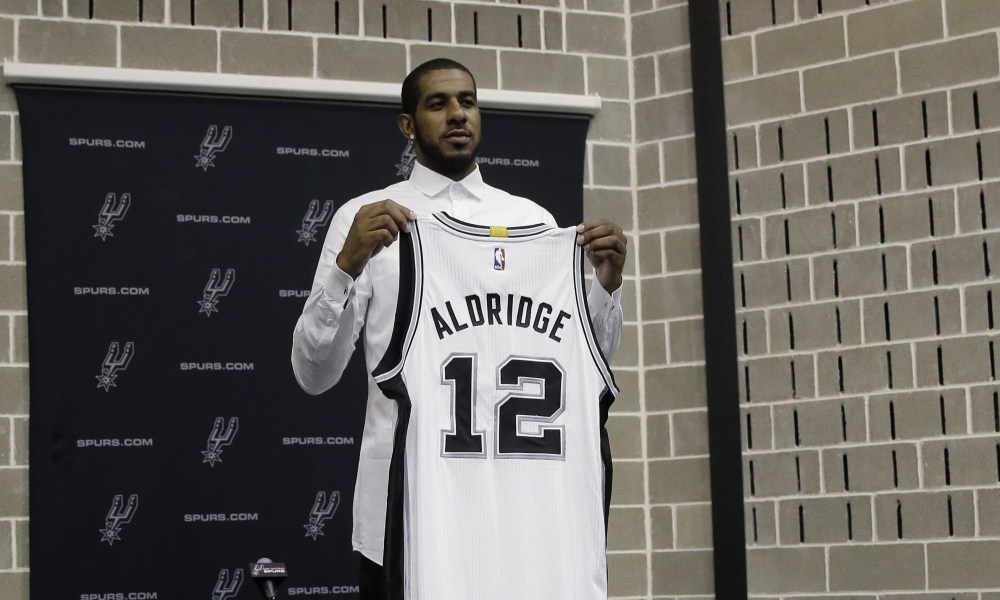
by Barry Klarberg | Jul 13, 2016 | Sports Business
Time is a precious commodity. In a fast-paced, media-saturated culture, time and attention are finite resources. The unsurprising result of their scarcity: getting a good night’s sleep isn’t a high priority for many Americans. For those struggling to keep up with constant digital media activity and the demands of work and family, sleep is an inconvenience.
That so many see sleep as an inconvenience that hinders productivity is problematic, as research increasingly confirms that sleep is critical to human health and physiological well-being.

John Singer Sargent, Peter Harrison Sleeping, 1905 (image courtesy of WikiArt)
New England Patriots quarterback Tom Brady ascribes to the view that sleep and well-being are inextricably linked. The elite athlete believes getting a good night’s sleep is critical to his performance on the football field. Back in 2014, Brady detailed his sleep habits in a Sports Illustrated interview. Now, his bedtime routine is the subject of public conversation once again. As part of their Dream In Black campaign, Brady has teamed up with Simmons to promote Beautyrest Black, a luxury mattress line.
“Sleep is the ultimate luxury,” Brady says in an inaugural “Dream in Black” advertisement, which debuted this past May. Brady, who turns 39 in August, is at an age when most elite athletes–let alone NFL players–choose to retire. But Brady is determined to keep playing and getting plenty of sleep, he’s convinced, will help him prolong his football career. In his Beautyrest Black endorsement, Brady aims to raise public awareness of the importance of sleep and the crucial role it plays in human health. Brady hopes that the Simmons commercial, despite its playful tone, will motivate more people to take sleep more seriously.
by Barry Klarberg | Mar 1, 2016 | Basketball, Sports Business
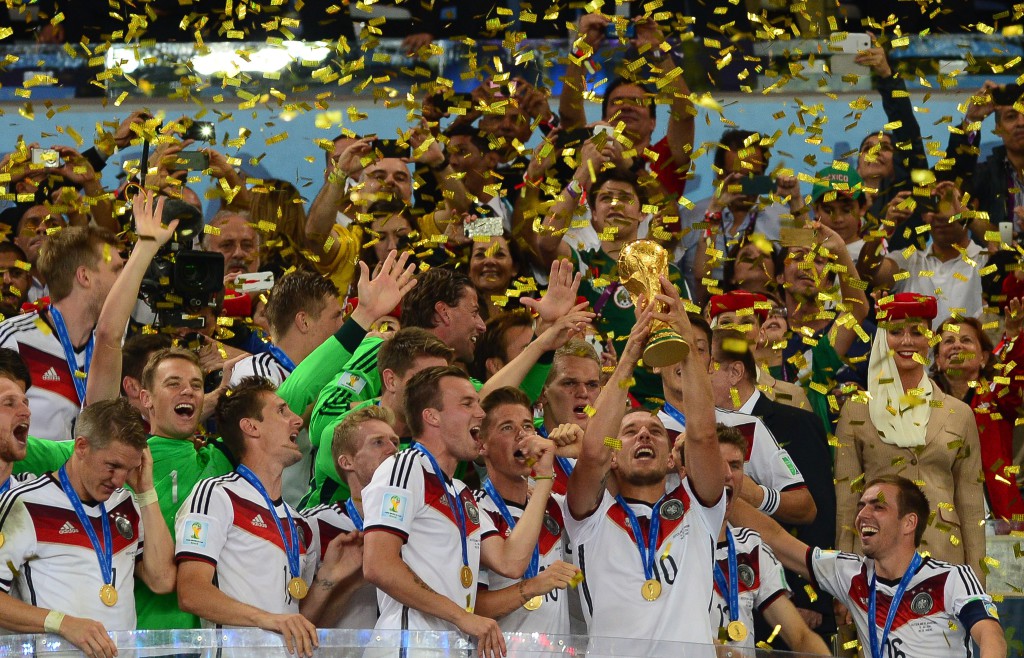
March Madness begins on March 15th. I don’t know about you, but I can’t wait for this year’s tournament to kick off. Ever since Duke topped Wisconsin to close out last year’s championship, I and many of you, have clamored for it to start all over again.
Not many other sporting events match up to March Madness. In fact, only a few global events come to mind. When it comes to American viewership, March Madness is joined by the only the Super Bowl, Olympics and World Cup as sizable events that consume viewers in many ways. This got me wondering which event reigned supreme financially.
Thanks to Analee Kasudia and Fortune, I found a helpful infographic (below) that broke down all the 2014 events, except for the Olympics (for some financial figures from the Sochi games, click here).
It shouldn’t come as a surprise that the biggest global event, the World Cup, generated the highest numbers from viewership (1 billion) to ticket prices for the final match ($7,066). Even when it came to a loss in employee productivity, the sport of the people’s ultimate event trumped all with $1.7 billion lost over the 2014 installment.
What might surprise you is March Madness’ financial gains as well. Over the 12 days of games (compared to the World Cup’s 32), March Madness raked in $9 billion in betting totals, $1.13 billion in ad revenue and boasted an average ticket price of $1,800 for the final game. Similar to the World Cup, March Madness cost companies $1.2 billion in lost worker productivity over its time.
In just one night, the Super Bowl held its own with $360 million in ad revenue, 114.4 million viewers (on 20 million for March Madness) and $3.9 billion in betting totals. Seeing as how many Americans pine for the day after the Super Bowl to be a national holiday, it should come as no surprise that the event costs companies $8.4 million in lost productivity the next day.
These figures didn’t present too many surprises, but it’s interesting to see where things shaped up during the last round of these events. How will they fare in 2018? Most likely, the positions will remain the same while the figures continue to trend upward as the world takes notice.
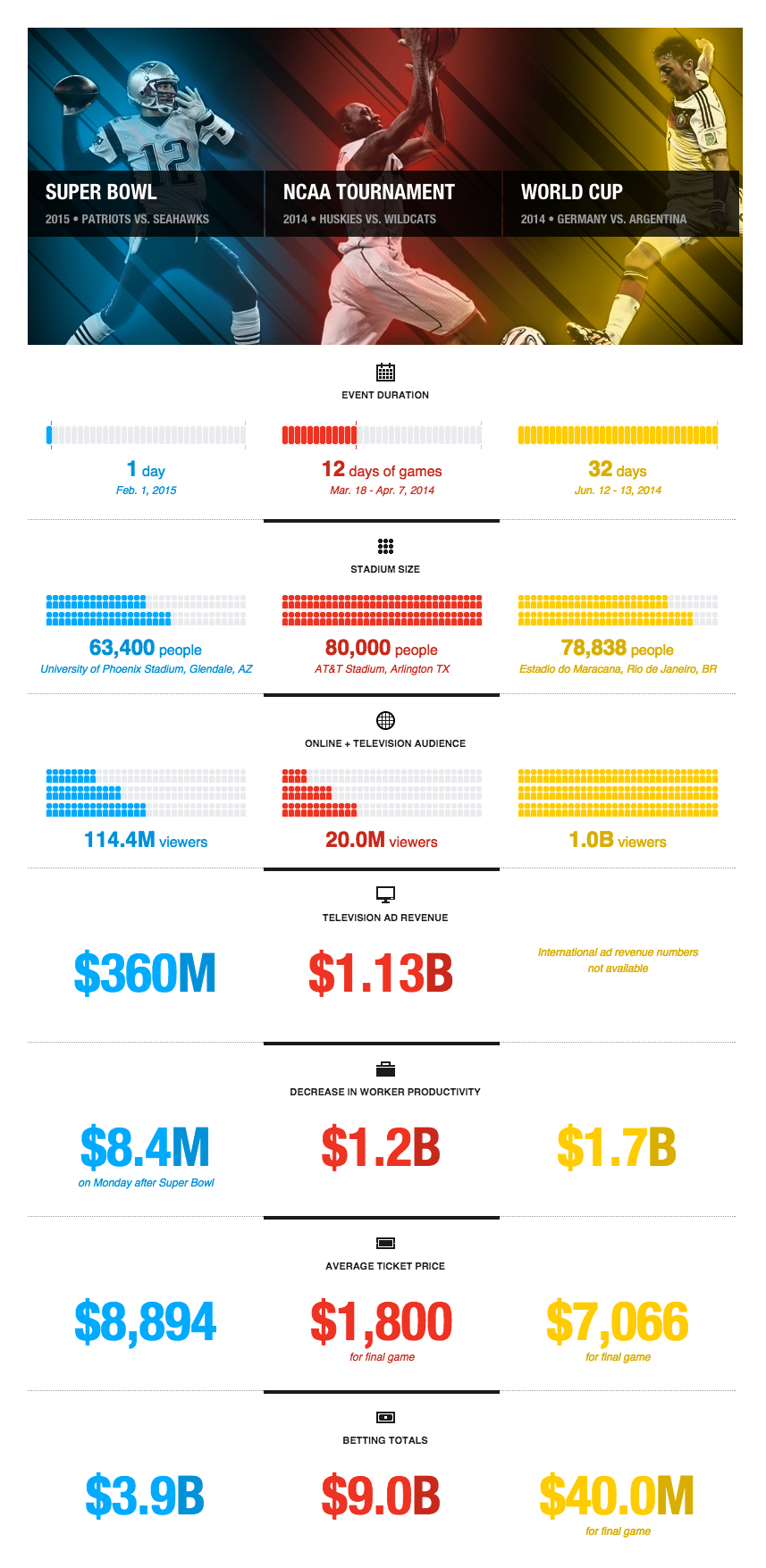
by Barry Klarberg | Feb 5, 2016 | Baseball, Sports Business
With the NFL coming back to Los Angeles next season, the league and two teams are certainly excited over the developments. Unfortunately, the fate of three teams hung in the balance with this move. For the once-again-L.A. Rams, their return to the Golden State is secure. But for the San Diego Chargers and Oakland Raiders, some details remain unclear. If the dust settles as expected, the Chargers will join the Rams in the two-team stadium at the conclusion of the 2016-2017 season. However if things change once again, the Raiders could still find themselves moving from the Bay Area.
If Oakland does lose its football team, the biggest winner could end up being the Oakland A’s.

O.Co Stadium During Baseball Credit: Wikipedia user Minesweeper
The reason is because Oakland is the last of America’s former infatuation with multi-purpose stadiums. Starting with Washington D.C.’s RFK Stadium through countless other cities and purposes, dual sports stadiums dominated the 60s and 70s. As decades moved along, though, the trend began to die as each sport needed its own kind of stadium to adequately hold its events. In time, teams moved on to their own stadiums.
Since the Miami Marlins’ move out of its multi-purpose home a few years back, Oakland’s O.co stadium became the last of the dying breed. In 2014, the A’s wisely renewed its lease for the next ten years despite being frustrated about the park. However, as USA Today notes, with the Raiders looking like they’ll stay in town, the A’s now must decide if they’ll stay at the antiquated stadium or seek its own stadium within the county. If the Raiders somehow have a change in fate, the A’s could be the last team left in town once the Warriors move across the Bay–a major boost to the team’s leverage for a new Oakland home.
All this talk doesn’t give proper attention to the fans of Oakland that may suffer most. Right now, their sports history looks mostly intact, but the city is no stranger to losing their teams. Could it happen all over again? Looks like we’ll have to stay tuned as this saga could still turn a few more times.
by Barry Klarberg | Jan 8, 2016 | Sports Business
For most major American sports, free agency season almost always brings about the most discussion and tension amongst fans, insiders and analysts alike. Almost every season, at least one big name player’s contract runs out and speculation about their next destination runs rampant–sometimes even months before the window actually opens up.
Some seasons are ones for the record books.
In 2010, literal years of speculation over where some of the NBA’s biggest names–including LeBron James, Dwyane Wade, Chris Bosh, Joe Johnson and several other game changing players–finally came to a head. That summer saw the formation of Miami’s Big 3 and several other marquee players change jerseys and zip codes.
Depending on the people you’re discussing the issue with, you probably will hear two different approaches to free agency. One belief believes that free agency doesn’t start until the first major contract is signed, dictating the salary demands and contracts of similar players. The other sees free agency as an open market with little to no order.
In truth, they’re both right at times.
When looking at free agency across the major sports in America, several factors help shape the market and much of the league’s demand.
At the end of the day, all markets are want vs need. In the NBA, the game saw a massive change when the largely small ball Warriors upended the league and its big men with a largely perimeter shooting approach to win last season’s trophy. That resulted in some teams changing their free agency philosophy. With several talented bigs on the market, some teams opted for different skilled position players. Certainly bigs like Greg Monroe and Robin Lopez found new homes, but did the market change after the Warriors brought their approach to the forefront? It’s hard to argue against that. Similarly so in Major League Baseball, some offseasons may see power hitters or ace pitchers fly off the market with massive deals. In other years, some of the biggest names will be some of the last signed. As Mike Axisa of CBS Sports explains, the MLB saw several different patterns form over the last few free agent periods, debunking much of the belief that the market waits on its biggest names.
Another big man from last season’s NBA free agent class, Marc Gasol, represents why the market doesn’t always wait for the big contract ink to dry. This past offseason saw huge names like Gasol, LeBron and Manu Ginobili mostly stay put with their old teams. When looking at how the order of deals went down this past summer, it appears that most teams knew this would be the case and opted to make complementary players more the priority. While some large signings came early on–including DeMarre Carroll joining Toronto and Brandan Wright joining us in Memphis–the biggest chip of the season, LaMarcus Aldridge, took a few days to sign. Certainly some teams waited for his decision, mostly hoping Aldridge would choose their club, while others swooped in for other options.
This can also be said in the NFL and NHL. The last NFL offseason certainly saw lots of names moving around at all different times during the window. 2014’s rushing leader, DeMarco Murray, weighed his options for a while before signing with Philadelphia in the middle of March–after a flurry of rumored signings for both sides. This happens at times. In other instances a player may overestimate their market and remain on the sidelines for a while before getting an opportunity from a team in need due to injury or lagging performance from the current roster. Other times, a player may be coming off a bad reputation and will have to deal with a declined market interest.
In short, while the marquee players and contracts certainly do dictate the temperature of the market, they don’t hold the rest of the market in a freeze until they sign. Depending on the circumstance, teams and free agents may take the plunge early, or hold off to see how the market shapes up over the window.
by Barry Klarberg | Dec 8, 2015 | Sports Business
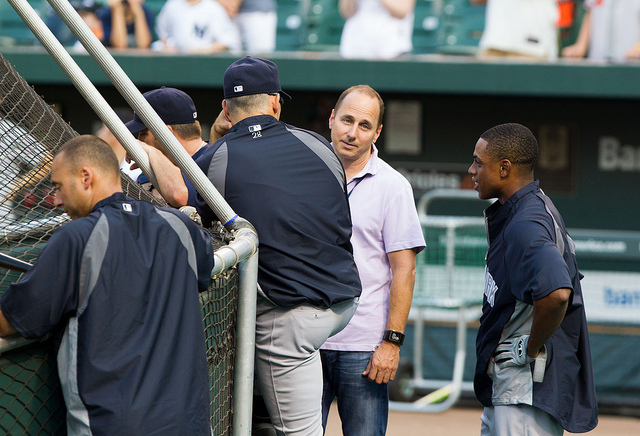
via Keith Allison
In almost all of our daily lives, whether it be for work or personal, involves some degree of risk assessment. From our want to sleep an extra half hour before getting ready to work to buying a new home to deciding if it’s time to look for new work or keep pushing through at your current job, risk assessment is crucial to all of us.
But we tend to forget that when it involves our favorite team. I’m not here to scold or chastise anyone because I’ve certainly done the same as a sports fan myself.
It’s tough, I get it. When your team drafts a player you didn’t want, a free agent goes bust or your team stands still at the trade deadline when you feel they needed that boost at a key position you want to voice your frustration.
“How does [so and so] have their job?!”
“I could do better than them!”
“What a bum!”
These are all things you may have said or heard–especially if your team fails to meet expectations for the season. So, allow me to play devil’s advocate for a second. As a fan, you are entitled to your opinion just like everyone else. However, do you really know what a GM’s (or the applicable person in the organization) job entails? It may surprise you to find out what goes into their job when it comes to assessing and managing risk. For the sake of this article, we’ll say it’s the GM making the calls but it could be others making these decisions.
Remember, as the late Flip Saunders told Vice Sports last year, “The overriding aspect of my job is putting a product on the floor that can be perennial playoff contenders,” he says. “We’re all in this to win a championship.”
When it comes to drafting the right player, a litany of needs, wants and demands make up a team’s decision. Not everyone will be happy–possibly even within the organization. From elite drafting franchises to those with spotty track records, selecting the right rookie to build up your club is one of the riskiest times in a GMs year. Take the 2014 NBA rookie draft class. It was packed with talent and potential. So far, the youngsters have taken a little more time to flourish in the league. Thus, some critics and fans have already written the entire bunch off as busts. Could they be right? Maybe. But it could also be age, a factor a GM has to explore. Rookies coming to the NBA, for example, have to adapt to a much more grueling schedule that tires them and potentially allows more room for injuries to occur than during their college seasons. Maturity can also be a factor, as well as the player’s immediate availability in the case of foreign players. These all go into consideration just as much as the player’s skills do.
Then there’s trades. Depending on the league, you may see more movement during the offseason or midseason. Additionally, even if your team had an agenda going into the season, an injury or contract impasse could result in needing to shift the roster to anticipate for short and long-term goal restructuring. In baseball, for example, Yankees’ GM Brian Cashman is likely on the phone as early as right after the June draft. Brian will likely end up fielding and sending a multitude of emails, calls, texts and meetings during exploratory talks with other teams over our’s and their needs. From there, the GM community likely will be in constant communication to discover who is available now, who is after the nonwaiver deadline, the Winter Meetings and other pertinent information. Sometimes this will result in deals being done while others fall through.
Regardless, the GM has to analyze every element from timing to chemistry to financial flexibility. It may seem easy when inputting your fantasy trades into a trade simulator like you’ll find on ESPN.com, but the intangibles make it much harder.
Shifting focus to free agency, a GM has to analyze and compete with other GMs in a slightly different way than they do during trade seasons. Now, the open market can augment your approach in several ways. In the NBA, the rise of the “poison pill contract” causes increased anxiety for countless GMs as they determine if matching a team’s offer sheet is in the best interest of the team. If they fail to sign the player, fans could be upset and the team may have lost a huge amount of financial flexibility in the years to come. But if they do sign the offer sheet, or sign other players that fail to meet expectations, scrutiny will fall on the GM in the immediate and long-term if the player is signed to a lucrative, long-term contract.
What if your GM has a relatively quiet free agency window? What if they don’t make many moves, or add low key acquisitions? They may receive scrutiny early and often until the team actually reaps the benefits in a few seasons.
In short, fans certainly have the right to their opinion when it comes to their team’s roster moves. But just like we do in our own lives, sometimes our assessments are off. It’s tough to have patience when our teams make mistakes, but if they only happen once in a while, maybe cut them some slack just this once.
by Barry Klarberg | Oct 19, 2015 | Baseball, Sports Business
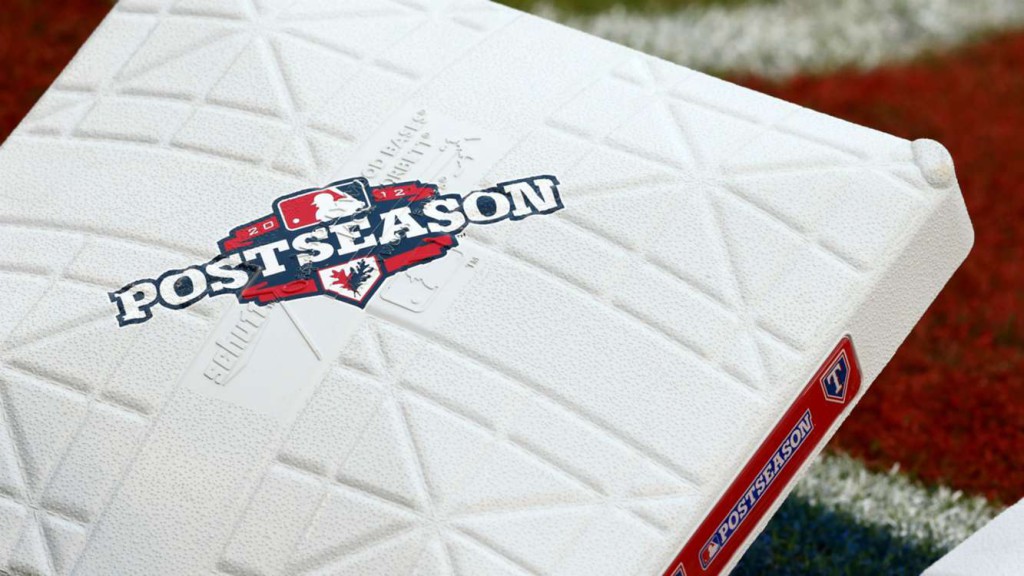
So far, this year’s Major League Baseball postseason has been nothing short of incredible. Despite my beloved Yankees taking an early exit, a fan of the game has tons to look forward to every game. From the Blue Jays back after over two decades to the Cubs blasting the ball out of the stadium at an incredible rate, eyes have been justifiably glued to screens for hours on end.
This isn’t just coming from an uptick in fans talking about the games either. Viewership across the four channels airing the games (ESPN, TBS, MLB Network and Fox Sports 1) is up nine percent from last season. As the LA Times notes, TBS is especially reaping in the viewers with its best ratings since the 2007 playoffs.
The LA Times elaborates that a two major factors are keeping fans glued to the screen: DVR and major market presence. With on demand services becoming a norm for most cable subscribers, they are able to focus in on every pitch while knowing that their favorite show will be ready for viewing whenever the game ends. Additionally, the article goes on to note that of the eight teams in this year’s postseason (excluding the one-game playoff), five are in the top 10 markets in America. With those loyal fans in place, as well as the Cardinals long-reaching Midwestern fan base, this year’s series garners more eyes than the game has seen in some years.
Coupling these key points with the stellar games that have occurred, it should come as little surprise that ratings are on the uptick this year. We’ll have to wait to see how the ratings fare at the conclusion of the playoffs, but if the games continue to pan out the way they have, nobody will be hoping to see the action end.






